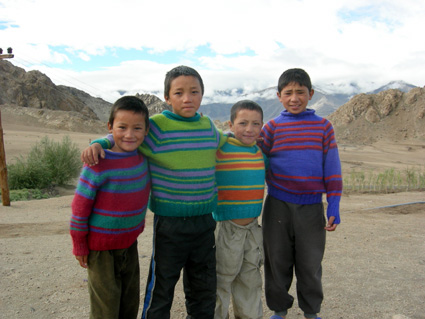 |
| The whole Himalayan
Kids Sweater gang: Sonam Namgyal,
Rigzin Namgyal, Tsewang Namgyal,
Rigzin Gurmet (cultural note -
the repetition of second names
does not mean they are in the
same family. Everyone has two
names, neither of which is a family
name. Namgyal means "victorious.")
|
For the past
five years, I've been traveling annually
to Ladakh, a mountainous, high-altitude
region of North India. I go there to
spend time at a charity boarding school
amidst a rambunctious group of boys
with whom I am hopelessly smitten. How
did I get there, meet these children,
and start this long-distance love affair
with several dozen little kids? It's
a long story. What you really want to
hear about is the knitting.
I learned
to knit on one of my visits to the
boys. I'm a quilter and fiber enthusiast,
and finding myself surrounded by women
who know how to knit at lightening
speed and boys who need warm clothing,
it seemed only natural to take the
plunge and learn. Knitting never held
any appeal for me in the past -- none.
But with long, unscheduled days away
from my own projects, I finally reminded
myself that knitting is a fiber art,
after all, so it wouldn't hurt me
to know how to do it. (Go ahead, mock
my naivete, anyone who has witnessed
me of late, unable to pry my fingers
from the needles except, perhaps,
to sleep.)
And so it
happened that I learned knitting from
women who don't speak any English,
who don't follow written patterns,
and who have a very hard time slowing
down enough to demonstrate for a beginner.
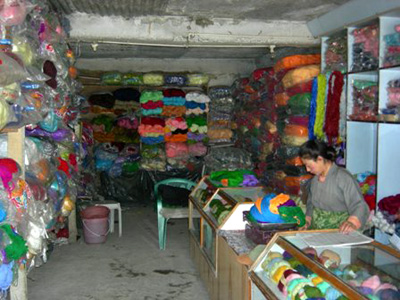 |
| The
LYS in Leh, Ladakh. Ache Lhaskit,
shopkeeper. |
What is the
world of knitting like, up there in
Ladakh? Bear in mind that I frequent
an urban center of sorts, a town of
30,000 people in a region of merely
130,000. There are yarn shops. One
kind of yarn is offered there, produced
in the mills of Ludhiana, Punjab,
and trucked over the mountains via
Kashmir. Everyone knits on the same
size needles, equivalent to a US#1.
They come in straight and double-points
(known as "sock needles"), they don't
have circulars. Even large projects,
if round, are executed on DPN's --
I once saw a woman walking down the
street, knitting a full-size sweater
on 12 inch DPN's (and it wasn't even
plain stockinette!) They sell needles
in other sizes, but they're not popular.
I knit one vest last year on Indian
8's (roughly a US#5), and the boys
commented that the needles were "fat."
There's only
one kind of yarn, but it comes in so
many luscious, saturated colors that
it's hardly a limitation. Merely a simplification:
no one ever has to worry about gauge.
Entering a yarn shop in Ladakh is an
assault on the senses. Pure color sings
out from every shelf, veritable bushels
of it spilling along every inch of wall
space. Indian shops are generally cramped
and dim, but the yarns are plentiful
and bright enough to draw me in off
the street. I look around like I'm the
proverbial child in a candy shop, wondering
where to dive in. I shop by touch --
the yarn is largely acrylic, and the
softness variable, so I feel for the
softest ones and then go for the best
colors within that soft realm. Again,
this is not limiting: I'm easily able
to buy more than I can conceive of using
in the near future (isn't that the normal
amount?) I hoard colors until I land
on a stripe scheme and plunge into the
next project.
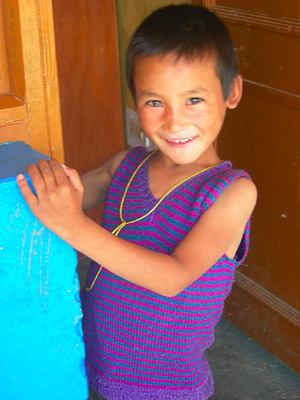 |
| My
very first vest is still in operation,
two & a half years later.
Modelled by owner Sonam Namgyal. |
In the beginning,
it was all about stripe schemes. My
first vest was fuchsia & blue,
fuchsia & blue, two rows of each,
and finished off with a purple neckline.
It was exactly like my favorite crayola
colors that all my childhood princesses
wore -- colors I could happily hang
with for the duration of the vest.
And the women taught me to knit the
vest flat, in two pieces, so it's
kind of like making socks: once you've
finished one, you have to start over
and do it again. I learned to do shoulders
(triple needle bind-off, unbeknownst
to me until months later when I heard
it explained at my Stateside LYS,)
and a ribbed v-neck with a double
decrease in the center. I could never
repeat the double decrease, and had
to be shown anew every time.
Doing one's
earliest projects on needles the size
of US#1 with a gauge of 6 stitches
per inch takes a lot of concentration.
My teacher Tsetan kept saying "tight
ma chos," and I understood what she meant, don't make
it tight, but how to not knit tight
eluded me. My stitches were so tight
I remember wedging the point of the
needle between yarn and needle and
twisting, worrying it in until the
body of it penetrated -- then the
problem was, how to wrap yarn around
and pull back through the unyielding,
forced hole I'd created. Many a false
attempt, until I'd hand it back to
my teacher who'd say "tight
ma chos" and
knit a few looser stitches, baffling
me. This method of learning requires
abject humility: despite the temptation
to question or explain, it's obvious
that no words are going to demonstrate
why Tsetan can knit loose and I can't.
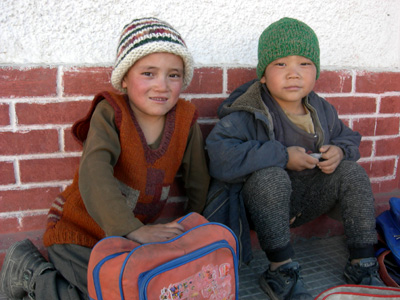 |
|
Sonam Tsewang
models my first intarsia project
and a hat from the Villa Marin
knitters in California - seen
here with his friend Stanzin
Chospel. |
I kept at it,
wrestling each stitch through with determination,
and wrenching the whole fabric along
the needle. You know what comes next
- the fateful tug that yanks a good
half dozen stitches off the needle.
This only happened when I was surrounded
by boys, and I'd duck my head and clear
out an arm's length around me and say
"whoa, hang on,waitwaitwait" and frantically
poke back through the little diminishing
holes that threatened to vanish with
the least jog of my elbow.
Imagine knitting
on size 1 needles before you learned
to loosen up, sitting on the floor of
a carpeted room with forty-some boys,
watching a Hindi movie on TV. The light
is barely good enough to knit by, but
I'm knitting a few stitches a minute
anyway, interrupted when the boys point
out particularly cool heroes, fights,
or motorcycles. Knitting, knitting,
pulling the stitches along, looking
up, pulling stitches -- yikes! -- off
the needle, looking down and POOF --
no power. Pitch black. Silence. The
boys don't scream like American kids
do when things go black. Failed electricity
is so normal they hardly react, apart
from some sighs and "Light song..."
("Light is gone.") But there I sit,
dropped stitches hanging off my needle,
no light, and bodies beginning to mill
around me. Often, the light comes back
after a minute or two. If not, I gather
my yarn and get up, pinching the dropped
stitches firmly, and make my way into
the hall where there may be ambient
twilight at least. I don't think the
boys had ever seen a woman so tense
about knitting. No one in their culture
would begin to learn at my advanced
age (i.e., over 30).
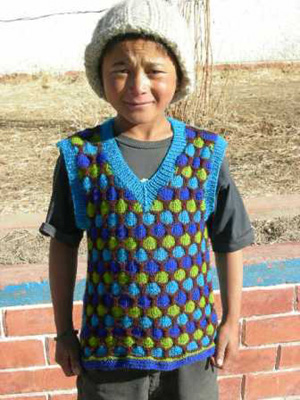 |
| Big Dotty hits
Ladakh! Shout out to Ann
& Kay - modelled by owner
Stanzin Chamba. |
Now that I'm
going back with some serious knitting
experience under my belt (witness:
the first year I made four vests;
the second year four vests and one
full sweater; this year I'm carrying
seven sweaters, three vests (one hooded),
and a vest and mini-poncho for me)
I plan to experiment with colorwork,
beyond stripes. I love stripes, but
all those colors beg for fair isle
designs. The only catch to this plan
is the environment: more than 80 boys
live there now, aged 3 to 14. The
best knitting under such circumstances
is that which can be dropped at a
moment's notice, to catch a ball or
help with homework or break up a fight.
If I need to pay attention, I may
have to wait until they're gone to
school. Okay, so I'll knit some stripes
for the social hours, and play with
colorwork during school time. These
days it's normal for me to have multiple
projects going.
The greatest thing about
knitting for 80 boys between the ages of 3-14
is it will always fit somebody! I
use these vests and sweaters as a training ground,
to see what I can do, and then it ultimately
wraps around the little body of someone I adore,
and I get to see my work running around the
most beautiful landscape in the world.
|

